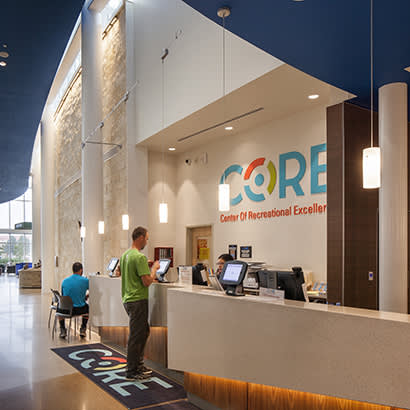
For an enhanced digital experience, read this story in the ezine.
We all have been working toward preparing and reopening our recreation centers post shutdown. Now it is important to step back and consider long-term implications and items that will influence and change the way we think about planning and design for recreation centers from here on out. To accomplish this, we must focus on adaptions to physical spaces, building systems and operations that will increase our versatility and adaptability in our new normal.
Physical Spaces
As we return to our facilities, it is important to keep in mind that perception is reality, meaning if someone does not feel safe going into their recreation center, they won’t go. Knowing this, we need to build trust and a sense of confidence that we are serious about protecting everyone’s health, safety and welfare.
To help accomplish this, building layouts must change to focus more on adaptability. Here are a few short-term actions that can progress into long-term modifications worth considering:
- Entry/Exit Strategies – If you can provide one way in and one way out, eliminating traffic through the same doorway, it makes people feel a lot better. Not only is it a more efficient way to transition classes, but also it helps people feel like they’re doing a good job maintaining physical distancing.
- Larger Entries, Circulation and Storage Spaces – One of the keys to adapting interior spaces during COVID-19 has been enabling guests to physically distance. Limitations to success have been pinch points at entries, tight corridors and small spaces for guests to gather before and after programs. Historically, architects and designers have tried to reduce or limit non-programable square footage, but they now know that without adequate circulation space, they cannot move people throughout recreation buildings or facilities with adequate safety buffers. Likewise, adaptable storage space enables rooms to become more flexible, accommodating extra furniture and equipment when greater guest separation is required.
Systems
Infrastructure will be one of the major factors creating versatility for park and recreation agencies in the future.
- Air Zoning – Managing airborne pathogens has forced park and recreation professionals to rethink airflow throughout recreation centers. One promising strategy is to increase the number of air zones within the building. Rather than having large areas with a single air exchange system, engineers are breaking a space into smaller air zones that can clean the air more frequently and effectively.
- Air Filtration – We predict that we are going to see more and more high-quality air filtration options and increased affordability. However, increased filtration requires more pressure and more power from heating and cooling systems, and so making this improvement will require careful evaluation.
- Humidity Control – Humidity controls may need to be modified. Some pathogens, like viruses, do well in a dry environment, while others, such as mold and spores, thrive in humid environments. Fifty percent humidity is optimum to avoid both, and also will help your patrons feel more comfortable.
Operations
Here are a few practices and protocols we believe may be here to stay:
- Visible Cleaning – Staff cleaning in front of guests sends a strong non-verbal message of your commitment to cleanliness. Also, increasing the use of touchless technology for doors, plumbing features and card swipes, reduces surfaces to clean. Perception of a clean environment is some people’s reality and can make or break their decision to come to your recreation center.
- QR Codes – Access to the latest information and instructions helps people feel informed and confident about how to participate safely. Fortunately, most guests have a smartphone readily accessible and with QR code technology, they easily can be linked to relevant and timely information throughout your facility. We are familiar with scanning QR codes in restaurants to access menus — in our facilities, we can use the same technique to allow patrons to access the latest safety policies, program offerings and schedules, as well as connect with instructors.
- Just Keep Going!
When considering implementing new, post-COVID-19 design standards, it’s understandable that your resources may be limited, especially until you find what is most appropriate for your facility and your community. In the meantime, we all need to be MacGyvers. We must be creative and extraordinarily resourceful in how we reimagine, reallocate and repurpose our facilities. Keep track of what works and what does not. This perspective will be vital when planning for a remodel or your next facility.
Craig Bouck, AIA, LEED AP, is a Principal and Strategy Partner at Barker Rinker Seacat Architecture (craigbouck@brsarch.com). Mick Massey, RLA, is a Senior Associate Texas Regional Director at Barker Rinker Seacat Architecture (mickmassey@brsarch.com).

